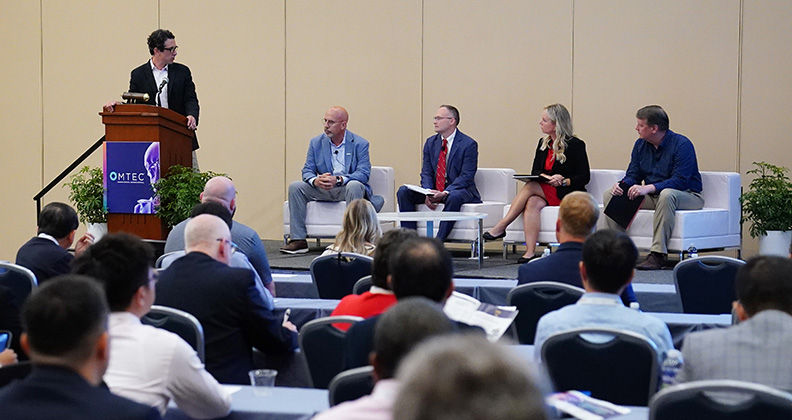
We hear and see the term “transformational leadership” a lot these days in conversations with managers and leaders, in articles in publications, on LinkedIn, and in other places. And it is important that we stop and ask ourselves: Do we all have the same working definition of this phrase? Having led organizations through successful transformation and worked alongside world-class transformational leadership coaches from Whatif Enterprises and Nexecute Group, I would propose the best definition I have seen — and that I have adopted for use — is:
“Transformational Leadership is the relentless pursuit of the organizational vision through the practices of: self-awareness, self-management, boundary setting, and honest conversations.”
Today, many people still use the words manage and lead interchangeably. It is very important to note a key difference: things are to be managed, but people are to be led. So, we manage what people do within a process, a work instruction, a training or even a timeline. Management is a transactional process, and therefore we measure its effectiveness by the presence or absence of the thing/transaction taking place (and perhaps in a given amount of time). Management is not a bad thing — it is just different than leadership, and we must know and recognize the difference.
Leadership is a transformational process, and therefore we measure its effectiveness by measuring the outcome. We continue to work with people, ask questions, and become curious until we discover the real answers. For example, as a transformation leader, we ask the question, “Why did we miss our month-end goal?” This is an outcome focused question that will require introspection on the part of the leader and the team. For a transformational leader, it is no longer acceptable to answer this with, “Well, we followed all the work instructions,” or, “We worked every shift at full strength.” These are transactional answers — and since we missed our end goal — are insufficient to help us uncover the real root cause of what is causing us to miss our goal(s).
The first thing we must know is that many of us have believed a lie about how organizations work. We have long thought of organizations as things that can be managed. But since organizations are made up of people, organizations are truly organisms — living, breathing creatures. We cannot reduce our orthopedic companies to a thing to be managed — even by changing words like “people” into “headcount.” We must drop the out-of-date idea that we leave our personal lives at the door and begin to embrace the truth that our story matters. Our background, upbringing, past experiences, the discussion we had with our spouse last night and our child this morning — these all matter and affect how we behave, think, speak and react in the here and now.
Robert Quinn beautifully illustrates a critical point in his seminal work “Deep Change.” In fact, he argues that the key factor at the heart of organizational change is personal change. The biggest hurdle to personal change is fear. If I change, what if I no longer fit in? What if they no longer want me here? What if I no longer enjoy it? …When transformational leaders demonstrate the courage to do the deep, difficult work of personal digging and change, they subconsciously create a safe space (and even a requirement) for others to do the same. Quinn argues that the leader who does the hard work of personal development and change “builds trust and credibility” (p.35) with the rest of the team.
“The fundamental characteristic of transformational leaders is self-awareness, followed by a desire for self-management.” (Freier, “The Choice to Show Up,” p.19) This is quite counterintuitive for most of us, because we are asking the question: How can I better lead/manage/influence others? So, our question is about our impact on others. However, we must ask ourselves: When I have experienced a great leader for whom I would do almost anything within my power to support, what has been my experience of him/her/them? How did I feel when I was around him/her/them? And what do I recall about what he/she/they did to make me feel this way?
For many of us, the answers to these questions include things like: I felt heard. He/She/They were truly present to me when we talked. I felt valued. Even when the conversation was tough (like when my performance needed to improve), I felt like he/she/they wanted me to succeed. I felt respected.
In answering these questions, we find out an interesting truth: the very things that made us feel most seen/honored/heard/respected (all things that we want for our people) are the things we worry will make us come across as “soft.” We long ago developed this belief that the hard-charging, type-A, bull in the china shop approach to leadership was the way to get great results. In fact, most of the recent research shows that approach is unsustainable and unhealthy for people (see works by Simon Sinek and Brené Brown).
The way we develop long-term buy-in and the kind of passion that makes teams want to do anything to achieve the organization’s vision is by making people feel heard, honored, respected and valued. And that can only happen when the organizational leader identifies what has made him/her/they feel that way.
So, I encourage you, no matter your role in orthopedics, to start your practice of self-awareness — and just as importantly self-management — today. When someone is speaking and you feel that anger rise up inside you, instead of spewing out words in an attempt to stop feeling that way, ask yourself, “What is that all about?” “Why am I tempted to react?” In doing so, you allow yourself to choose how to respond instead of allowing your emotions to dictate how you react. Pay attention to whatever thought or memory comes to mind in that moment. That memory is the key to understanding what triggered you, and better understanding how part of your story from the past is coming up now.
I, myself, had a team member who talked over the top of me repeatedly in a stand-up meeting, and I felt the anger building inside of me. Unfortunately, instead of being curious in the moment, I raised my voice and yelled at her to stop doing that. It was only as I walked away that I wondered to myself, “What was that all about?” I immediately had a recollection of feeling ignored and not listened to growing up — ugh!
I circled back to ask forgiveness for my outburst, first with the team member one-on-one and then with the team as a whole. Then, I shared with them the internal self-awareness work I did and committed to taking a deep breath and being curious about my internal emotions moving forward before I spoke. While it was not my intention when I did so, many team members later admitted that this interaction did two important things for them: 1) it allowed them to be imperfect and make mistakes — and admit to those flaws without worry of retribution, and 2) it encouraged them to continue their own internal work of self-awareness and self-management.
Being self-aware is being curious about your emotions, feelings and reactions in the moment. Practicing self-management is choosing healthy actions (deep breaths, thoughtful word choice, honest and kind feedback in the moment, etc.).
So, I encourage and challenge you to begin to do the things for your team that always made you feel heard, honored, respected, etc. Put your mobile phone and computer aside when talking to — or even more importantly, when listening to — one of your team members. Ask questions to clarify that you understand what they are saying. Find out about their lives outside of work and check in with them on those things, too. Transformational change within orthopedic organizations starts with the transformational change within the people. Be the courageous one to lead the change you want to see in your organization.
Patrick Davidson is the Founder of CoStratEx. He plans to write a follow-up article on boundary setting and honest conversations.
Patrick has spent two decades helping organizations to learn disciplined strategic planning & focus, how to develop a healthy culture led by a cohesive, high-functioning leadership team and brilliant execution and measurement systems. He’s held leadership positions at Beaver Aerospace & Defense, Orchid Orthopedic Solutions, and Metalmite Corporation and assisted many other organizations as a trusted advisor through his company CoStratEx.




